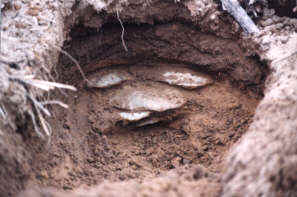|
My interest in Indian artifacts was sparked in 1985 when I was 14. I was walking through a field
near Waukesha, in Jefferson County, Wisconsin, when I stumbled over an object that had escaped the ravages of the
plows for centuries. A local museum curator told me it was a celt. My Uncle Tim Lent took up the hobby in 1988.
In 1992 he twisted my arm tojoin him on one of his outings. The very first day I found two whole points and was
hooked for life. Tim and I go out as often as possible after gaining the land owner's permission for any field
that seems to have promise. We have found a variety of points, scrapers, drills, Celts, pot sherds, game balls,
and even adzes, which only fanned my spark into a flame.
On April 28th,1998, my grandmother, Marilyn Lent, died. My Uncle Tim and I had our own way of
dealing with it. We decided to lose ourselves in the peace and quiet of an Indian artifact hunt. We hunted three
sites in Jefferson County and still had a bit of time left. I had always wanted to check out the sandy hump across
the road from the site we had looked over. I walked over to the area and discovered six pieces. I had read about
people finding groups of artifacts like this and knew it might be a cache. Since I had funeral leave, we decided
to go back to take a closer look. I locked the coordinates in with the aid of the Global Positioning Satellite.
My Uncle Tim and I divided the pieces equally, three each.
On April 29th, 1998, Tim had to work, so he didn't join me. I brought a rake and some gardening
tools to look for anything else that had been scattered by the plows.
I started my search where the first piece had been found on the surface. The artifacts from the
previous day had been scattered to the north. I raked two rows to a depth of six to eight inches below the surface
and fifteen feet to the north. I found five more blades. Then I headed south about fifteen feet and came across
another blade. Raking the same spot, I found still another. Six blades were out of the ground, confirming that
I had indeed located a cache. I cleared the sand away and began to photograph my find. The depth of the cache was
eight inches or less in the plow zone. Then I began digging by hand. Sixty six pieces were saved from the plow
that day, and only one was broken. I didn't want to attract too much attention to what I was doing so I took off
my jacket and filled it up to make the trip back to my truck. I stopped at my Uncle Tim's house on the way home
and greeted him with, "You're going to love me and hate me!" Tim was surprised by what I had found, as
was I. It didn't hit me for a while; I guess I was in shock. I knew there would be more scattered by the plow,
but I never expected anything of this magnitude. Tim gave back the three pieces from the first day's hunt.
|

Five of the cache blades found undisturbed by the plow just as their prehistoric
owner had left them.
He said that since I had found the first piece and that it was a cache, it should be kept together.
On May 3rd, 1998, I raked a good sized area around the cache site, and only three more blades
turned up. My Uncle Tim had decided to walk the field across the road. He was fortunate to find the first axe either
of us had ever found. It was a full-grooved axe and was beautiful, but that is another story.
On August 11th, 1998, I returned to the field, which had been planted in corn. I had to know
if there was any more. I used the Global Positioning Satellite to locate the general area, then I walked row-by-row
and found five more pieces on the surface. As of August, 1998, there are eighty pieces in the cache. The cache
consisted of trimmed spalls, blanks and preforms. The smallest is 2 3/8 inches long by 2 inches wide. The largest
blade is 5 7/8 inches long and 3 3/4 inches wide. The total weight of the cache is 17 pounds. The material appears
to be raw Harvester and Crescent Quarry chert from the Burlington formation in Missouri. None of the
Article continues on next Page
>
|




